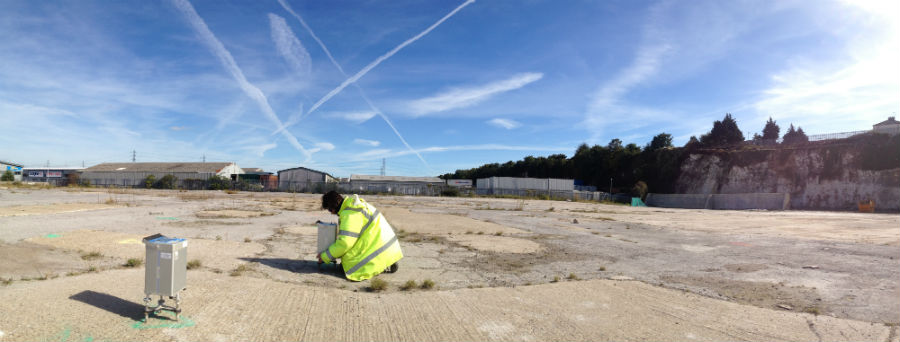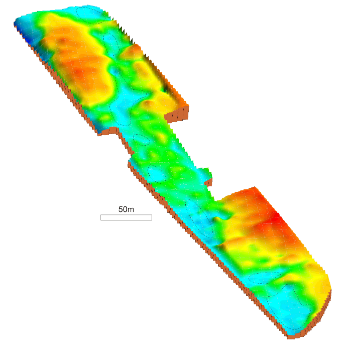Ever wondered how your gas, water, electricity and broadband are supplied to your house? Or why you are stuck in yet another traffic jam where there is an open hole in the ground?
Most utility services, including electricity, water, gas and telecommunications are distributed using buried pipelines or conduits, or via directly buried cables. The majority of this buried utility infrastructure exists beneath roads. Some of these are over 200 years old and indeed, we are still using Roman sewers. Consequently, we often do not know where these pipes and cables are when they need repair or replacement. This leads to excavations in the wrong place adding to the congestion and delays.

Several different technologies exist to see through the ground, but many rely on transmitting an electromagnetic wave through the ground which is then reflected of a buried pipe or cable with the reflected signal received at the ground surface. However, the ground, especially wet clay, can make it really difficult to see anything deeper than a few centimetres.
As these pipes and cables are buried up to several metres below the ground surface, an alternative technology such as micro-gravity needs to be utilised. This technology measures the gravitational field of the subsurface by measuring density variations. This sounds easy, but existing sensors are affected by the density of surrounding buildings or features, vibration from traffic and wind and ocean tides to name but a few. This limits the possible resolution, so smaller objects cannot be detected.
In 2010 the GG-TOP Birmingham Civil engineers and physicists began collaboration to bring a new capability to underground sensing through exploitation of quantum technology (QT). Using a technique called atom interferometry, cold atoms are used as ideal test-masses to create a gravity sensor which can measure a gravity gradient rather than an absolute value. This suppresses several noise sources and creates a sensor useful in everyday applications. This collaboration has grown and become a key aspect of the UK National Quantum Technology Hub in Sensors and Metrology, which aims to bring a range of quantum sensor devices out of the laboratory and into the real-world.
*Image Courtesy of RSK
 It brings together two complimentary skill sets. While the physicists work on creating an advanced QT sensor, the Civil engineering team provides guidance on how it needs to be used and what problems need to be addressed. This is a diverse activity, including close collaboration with end-users, such as geophysical surveying companies, to understanding what the applications and limitations of existing technologies are, known as the ‘competitors’. More importantly, it provides a reality check as the developing QT technology has to survive the harsh environment on site. At the same time, we are the early adopters of the QT sensor and trial early prototypes, helping to create a roadmap for potential applications. The interdisciplinary nature of the collaboration creates an exciting environment, in which we work together not only to better understand how our sensors have to perform, but also how to make them bring a real benefit to applications.
It brings together two complimentary skill sets. While the physicists work on creating an advanced QT sensor, the Civil engineering team provides guidance on how it needs to be used and what problems need to be addressed. This is a diverse activity, including close collaboration with end-users, such as geophysical surveying companies, to understanding what the applications and limitations of existing technologies are, known as the ‘competitors’. More importantly, it provides a reality check as the developing QT technology has to survive the harsh environment on site. At the same time, we are the early adopters of the QT sensor and trial early prototypes, helping to create a roadmap for potential applications. The interdisciplinary nature of the collaboration creates an exciting environment, in which we work together not only to better understand how our sensors have to perform, but also how to make them bring a real benefit to applications.
So what does the future hold? Applications go well beyond locating pipes and cables, but include sinkholes and buried mineshafts as well as unknown ground conditions. A multi-sensor approach including QT-sensors will reduce risks from urban excavations by making the ground invisible, so that we can see through the surface of our towns and cities. This maximises the opportunities of the subsurface, the greatly underused third dimension. This is needed to future proof our cities and links to other research at Birmingham such as Liveable Cities. It is true that because we cannot see it, we instinctively do not readily think of the ground as an enabler of more sustainable urban environments. More importantly there are perceived risks associated with engineering in a space that we cannot see clearly. Not seeing what is in the ground can have major, and occasionally extremely dramatic, consequences. Thus, in order to exploit the subsurface to its full potential, a thorough understanding of what is in the ground is essential to minimise this risk.
The national QT Showcase event at the Royal Society this week will highlight the collaboration and provide an ideal platform to engage with different stakeholders interested in applications as well as fundamental physics.
Dr Nicole Metje is Senior Lecturer in Geotechnical Engineering and Dr Michael Holynski is a Research Fellow, School of Physics & Astronomy